Masterpiece Story: The Pineapple Picture
Known as the “pineapple picture,” this enigmatic 17th-century painting captures the royal reception of King Charles II. The British royal...
Maya M. Tola 3 September 2024
In the 20th century, the electrically lit city painted by Georgia O’Keefe, Edward Hopper, and Joseph Stella became a standout feature of modern art, as unmissable as a neon sign. However, almost a century earlier the city at night had already captured the imagination of European artists. Their works were known as “urban moonlights,” constituting a genre almost forgotten today.
Let’s take a closer look at moonlight paintings!
Artists depicted capital cities from London to Constantinople, from Dresden to Venice, but always with the same three elements: a full moon reflected in the water; a monument seen from across the water; and a group of figures, whose role was to inspire us—the spectators—to contemplate the beauty of the nocturnal city. Urban moonlights often featured cities’ most well-known churches and castles, making them easily recognizable to a broad audience.
This genre was extremely popular all over Europe and remained so for about a century. In Venice, Ippolito Caffi’s nighttime views caused a sensation, meanwhile Aivazovsky’s moonlight paintings “sold like hot cakes,” according to his friend Dostoyevsky. These paintings capture an uncommonly beautiful vision of European cities before the advent of modern lighting completely transformed the appearance of the city after dark.
In the 19th century, two elements contributed to their popularity. Firstly, the timeless and peaceful glow of moonlight provided a nostalgic contrast to the commotion of the industrial metropolis. Secondly, the artists’ depiction of centuries-old monuments, such as Notre Dame Cathedral, Westminster Abbey, or the Colosseum, created a reassuring connection to the past.
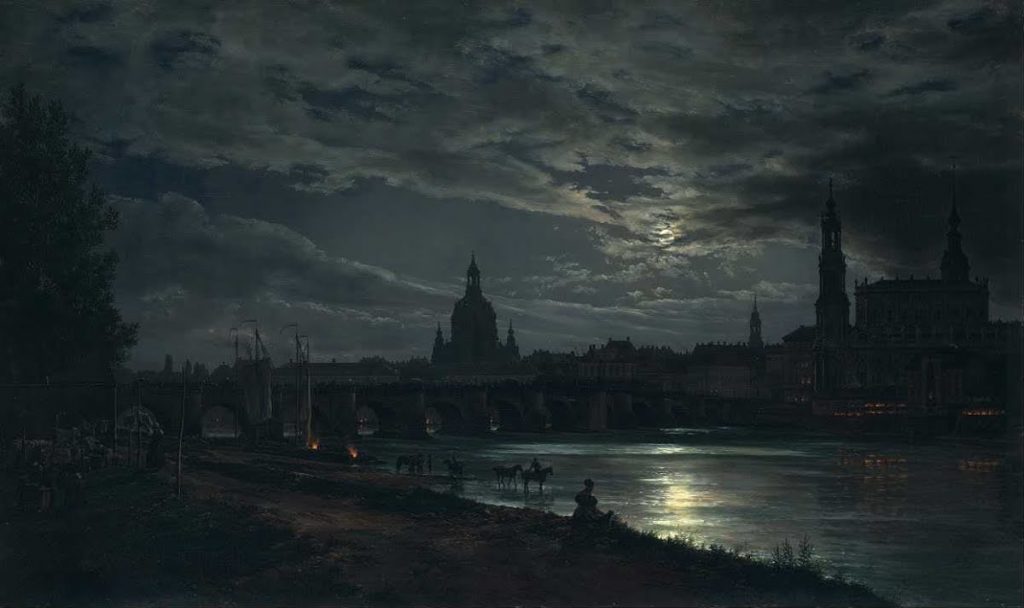
Johan Christian Dahl, View of Dresden by Moonlight, 1839, New Masters Gallery, Dresden State Art Collections, Dresden, Germany.
Perhaps the best-known moonlight picture from this early period is Dahl’s View of Dresden by Moonlight (1839). Here, the artist divides our attention between the monuments of the city—such as the large dome of the Frauenkirche on the left—and the complex interweaving patterns of the clouds, which almost hide the moon itself. Meanwhile, a woman sits with her dog on the shore, contemplating the tranquil reflections of the moon on the river Elbe.
While Dahl was painting the Baroque architecture of Dresden, Pether was producing his first moonlit views of London. Pether’s works would eventually include the major buildings of the city, from the Tower of London and Lambeth Palace in the east, to Buckingham Palace and Windsor Castle in the west. His vast output gives us a glimpse of the vanished beauty of Victorian London, which would otherwise be known to us only through black and white photos.
Although it might be tempting to think that it was the monuments that took center stage in 19th-century moonlights, the exploration of the relationship between urban and rural was never far from artists’ minds. They lived at a time when cities like London were expanding as never before, making nature seem more distant than ever.
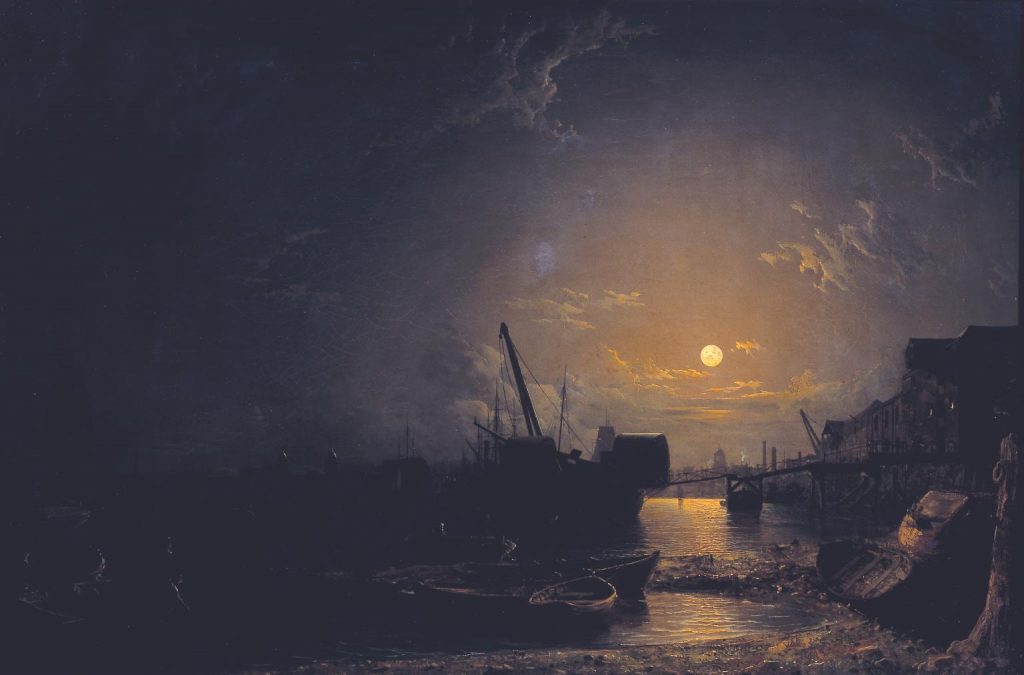
Henry Pether, Greenwich Reach, Moonlight, ex. 1854, Tate Britain, London, UK.
In Greenwich Reach, Moonlight (ex. 1854), Pether paints a dramatic chiaroscuro scene showing a maritime world far removed from the lives of city dwellers. This work harks back to the depictions of harbor life by 17th-century Dutch painters, as one maritime culture reflects on another.
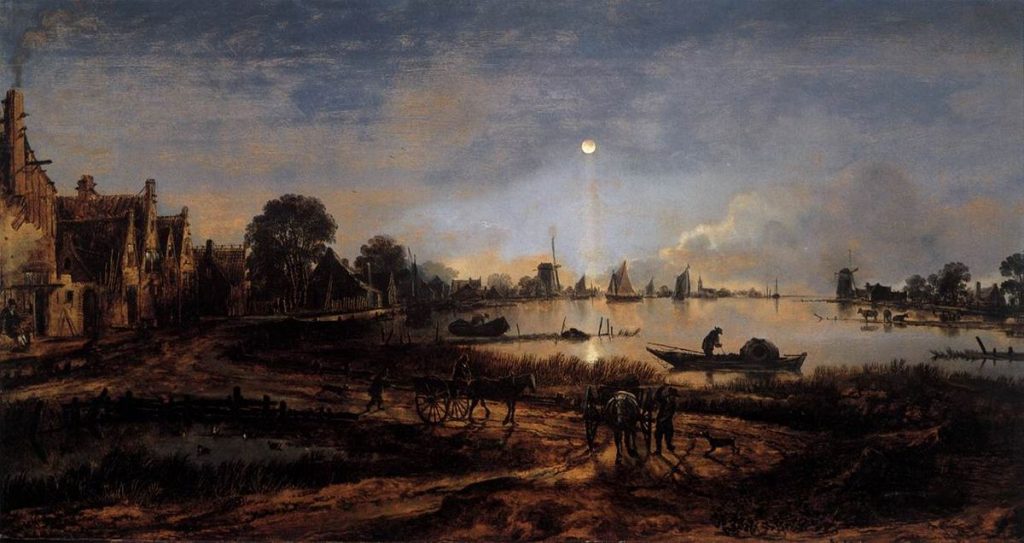
Aert van der Neer, River View by Moonlight, c. 1645, Rijksmuseum, Amsterdam, The Netherlands.
In fact, the popularity of moonlights owed much to the Dutch example. In 17th century Holland, landscape artists such as Aert van der Neer and Aelbert Cuyp were already painting idyllic scenes where ordinary people went about their daily tasks against the backdrop of a canal glistening in the moonlight. While these small paintings celebrated the beauty of the Dutch countryside, painters were not yet inspired to paint urban scenes illuminated by the moon.
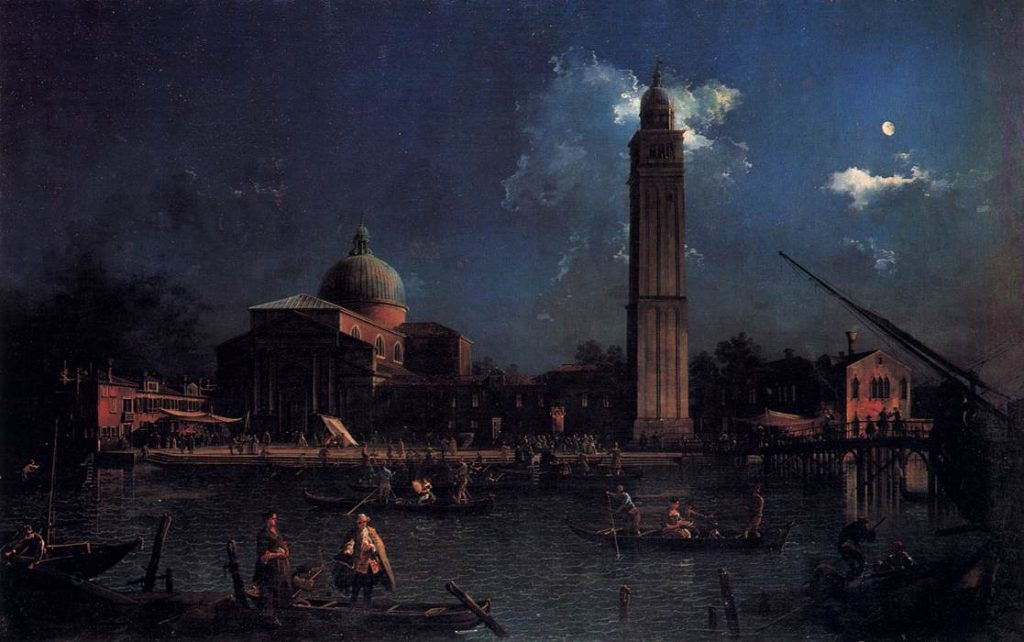
Canaletto, The Vigilia di San Pietro, 1755, Gemäldegalerie, Berlin, Germany.
A century later, the Italian artist Francesco Guardi—famous for his detailed views of Venice—painted a moonlit landscape called Capriccio Landscape with a Lagoon by Moonlight (c. 1740). Only ten years later, his rival Canaletto produced an unusual work called The Vigilia di San Pietro (1755). This piece shows well-to-do Venetians being ferried along the canal, in what might be the first urban moonlight in history.
Whereas in the 18th century, English travelers might buy views of daytime Venice, by the 19th century, those same travelers might have bought a nighttime view of the city, akin to later tourists buying postcards. However, the addition of moonlight transformed these well-known sunny and bustling scenes into something tranquil and romantic.
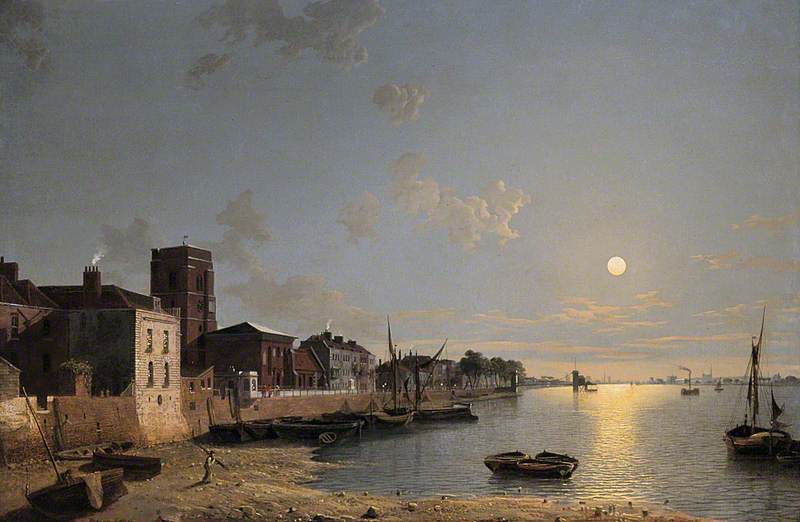
Henry Pether, Cheyne Walk in Chelsea, London, by Moonlight, 1850, Museum of London, London, UK.
Cheyne Walk in Chelsea, London, by Moonlight (1850), provides a fascinating insight into how a much-changed city like London looked before the developments of the 20th century. By combining the detailed topography of Canaletto with the restrained palette of van der Neer, Pether created a novel style that achieved compositional clarity while also retaining the brooding poetry of his Dutch predecessor.
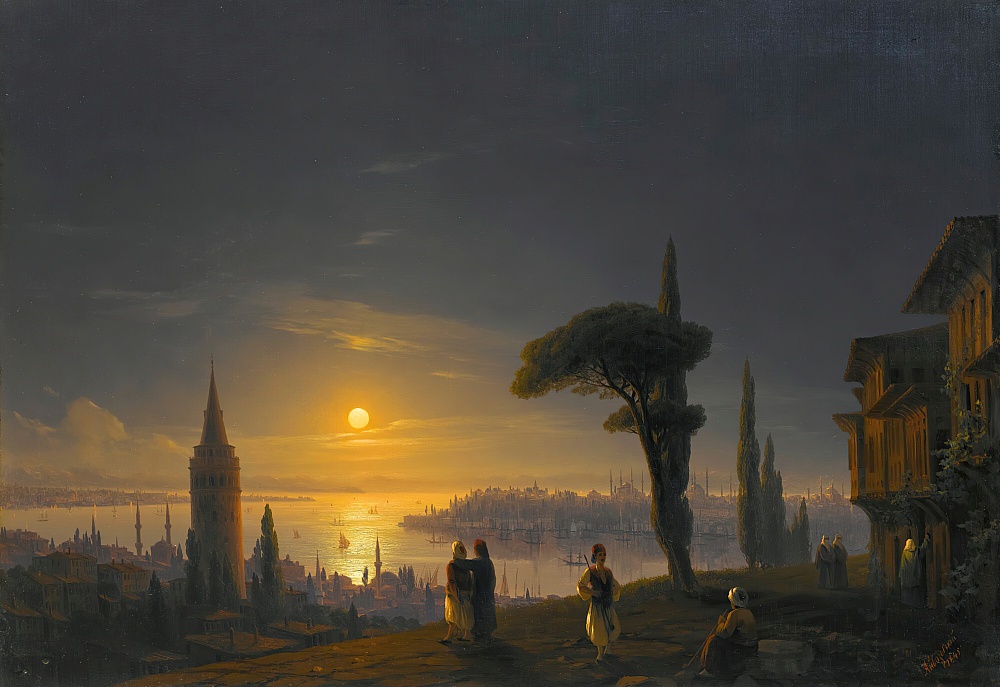
Ivan Aivazovsky, The Galata Tower by Moonlight, 1845, Private Collection.
In The Galata Tower by Moonlight (1845), Aivazovsky shows a clear division between country and city, separated by the bay known as the Golden Horn, just as Dahl had done six years earlier in his View of Dresden by Moonlight. Still, there is a sense of harmony between urban life and rural life; the natural elements have come creeping right up to the edge of the city. Although today these low houses have been absorbed into the neighborhood of Beyoĝlu in modern Istanbul, at the time, they were still surrounded by greenery.
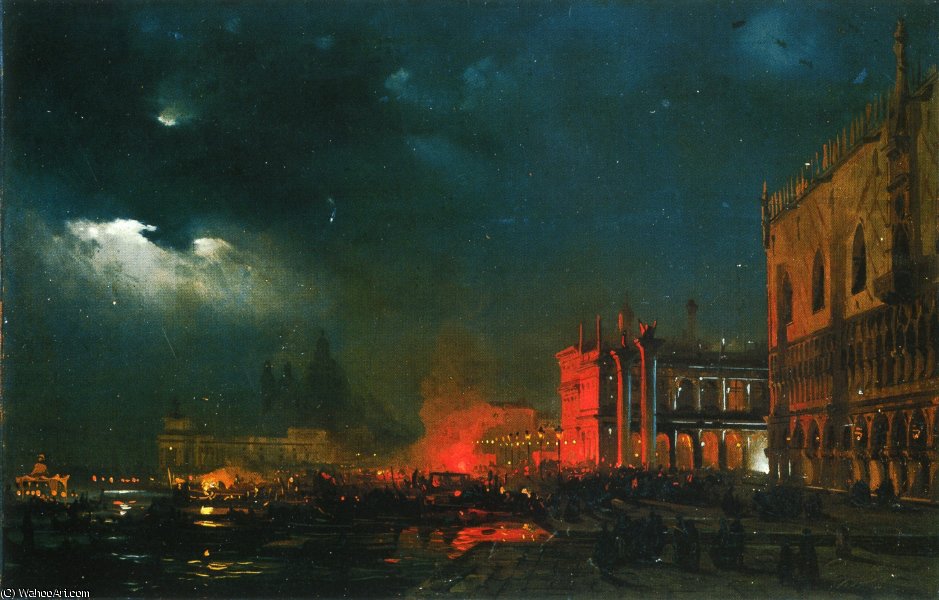
Ippolito Caffi, Nocturnal Celebration on the Molo seen from San Marco, 1858, Private Collection.
In contrast to northern painters such as Pether, Dahl, or Aivazovsky, who tended to focus more on realistic depictions of daily life, the Italian Caffi took a very different approach. Coming from a long tradition of theatricality in painting, his Nocturnal Celebration on the Molo seen from San Marco (1858) uses dramatic contrasts of light and shadow to make the center of Venice look almost volcanic.
As the century progressed, urban moonlights retained their main compositional elements but also began to incorporate new ones. Technological innovations and growing populations began to change the outward appearance of London, Paris and even places as timeless as Venice. In Pether’s middle period, he didn’t hesitate to include industrial features—such as a modern smoke stack, a steamboat, or even the new cast-iron construction of Westminster Bridge—in his peaceful nocturnal scenes.
During the time that European painters were representing their capitals by moonlight, the night itself was undergoing major transformations. For example, in 1807 the first gas lights were installed in the streets of London, impinging upon the serenity of moonlit evenings in the city. This made it harder for artists to see the true colors of the world around them. Ironically, the beauty of the night was only really being discovered by the public at a time when improvements to lighting technology made for safer streets and easier strolling. Moonlight was an endangered species, and these artists knew it.

Henry Pether, Moonlight on the Grand Canal, c. 1850, Private Collection.
When the English art critic John Ruskin returned to Venice in 1845 to escape the rapid modernization of London, he was horrified to see that the Grand Canal had been lit by gas. Pether’s Moonlight on the Grand Canal, Venice (c. 1850), depicts the embankment in front of the Doge’s Palace by the orangey light of gas. Yet the artist still chose to let the moonlight dominate.
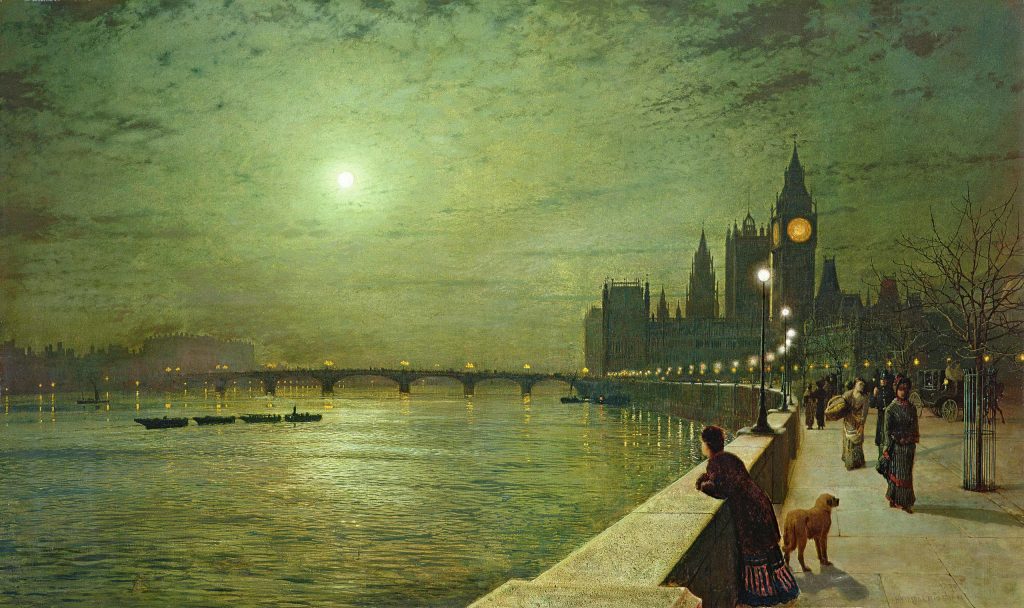
John Atkinson Grimshaw, Reflections on the Thames, Westminster, London, 1880, Leeds Art Gallery, Leeds.
Towards the end of the century, the glaring light of electricity transformed the night even further. Reflections on the Thames, Westminster, London, painted by John Atkinson Grimshaw in 1880, just a year after the first electric lights appeared on the Victoria Embankment, could be considered the last gasp of urban moonlight. A layer of thick smog obscures the full moon and the clear purity of the night sky, as moonlight, gas, and electricity all vie for the spectators’ attention.
By 1909, as the world entered the age of the automobile, moonlight had become so synonymous with the past, and with a contemplative atmosphere favored by the Romantics, that when the founder of the Futurist movement, Filippo Marinetti, published his second manifesto, he titled it Let’s Murder the Moonlight!
Although Marinetti didn’t succeed in making us forget the beauty of the past, the moonlight that he wanted to murder was already dying a slow death. By this time, most European cities were lit by electricity, making the glow of the moon ever more difficult to see.
While the urban moonlight genre sought to capture “natural” light, it was anything but natural, as these works were done in a studio rather than outdoors. Nonetheless, artists aimed to create a harmonious synthesis between landscape and architecture, nature and culture, in works which suited the aesthetic sensibilities of their time and continue to absorb and enlighten us today.
Author’s bio
William Henderson Sharpe is currently doing a PhD in Art History at the University of Strasbourg about the masked ball in Belle-Époque painting. Before getting a masters at the Sorbonne, he received diplomas in composition and orchestration from the Écôle Normale de Musique de Paris. William enjoys drawing, photography, reading, and classical guitar.
DailyArt Magazine needs your support. Every contribution, however big or small, is very valuable for our future. Thanks to it, we will be able to sustain and grow the Magazine. Thank you for your help!